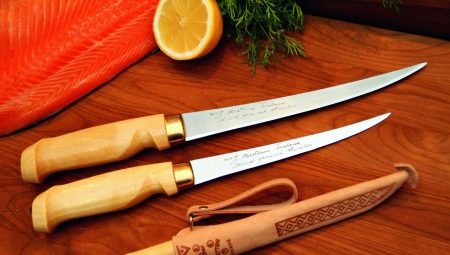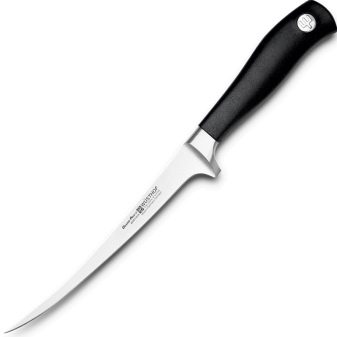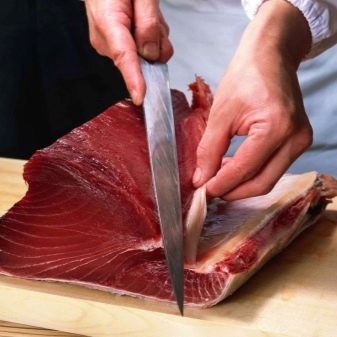Fillet knives for fish: rules for selection and use

The knife can be considered one of the most ancient tools mastered by man. Of course, over thousands of years, it has turned from a universal cutting tool into a whole family of similar externally, but at the same time somewhat different in functionality, objects. In this article we will focus on special fish fillet knives. The development of this type of tools began with the beginning of the mass catching and harvesting of fish.
Butchering fish for sale has always been difficult, and when this process acquired an industrial scale, a special professional tool of labor was needed.
Peculiarities
A fish or fish fillet knife looks pretty unusual. It differs from other knives primarily in shape. The tool is equipped with a slightly curved, long and narrow blade. The length of the blade is variable and assumes the use of tools with different lengths of cutting blades for fish of different sizes (from 14 to 30 cm). The most commonly used tools are considered to be with a blade length of 16-21 cm. Sharpening is very important, ideally it should be no more than 25 °, but 15 ° is often used.
Working with fish requires a comfortable handle that won't slip out of your hand. Initially, it was made of wood; modern versions of the products have handles made of special plastic or rubber.
In a home or restaurant kitchen, the factor of a persistent fishy smell becomes important, which over time permeates the wood of the handle, and the use of modern materials makes it possible to avoid this.


The fillet for fish gradually from the shops of fish processing enterprises, where it was simply called a fish knife, began to migrate to the kitchens of restaurants, and then to home ones. The development of the restaurant business has led to the emergence of a special form of tools for various operations performed with fish.
Gutting large fish required a large knife, often with a serrated blade. Without such a knife, it will be very difficult to butcher a large salmon with its strong skin. It is convenient to cut cod with a fillet, which has grooves on the surface of the blade, which will prevent the meat from sticking to the cutting surface.


Since it is very problematic to buy fresh fish far from port cities, since this perishable product goes on sale deeply frozen, a special slicer was required to cut frozen fish.
Cutting the fish neatly is a real art. Special knives have an elongated blade. Slicer varieties will help you cut the fish into slices, cubes or even strips.


Somewhat different requirements apply to a serving fish knife served with a dish. It is used at the table for cutting cooked fish into portions.
In the second half of the 20th century, electric fish knives appeared. The apparatus is equipped with a typical long, slightly curved blade, sometimes serrated. Most often, the tool kit of such a device includes several interchangeable blades that allow you to carry out various operations with different fish. The comfortable handle is equipped with an electric drive, which produces cutting movements.
This device is powered either from batteries or from the mains.


Top manufacturers
Currently, the production of fish knives has been established in many countries. However, Finnish, German, French and Japanese companies have traditionally been the best manufacturers of this inventory for at least half a century.
But the review of the manufacturers will not be extensive.
Famous Finnish companies Rapala and Marttiini offer a wide range of kitchen knives, including for fillet cutting. This is perhaps the most preferred product for the home, so to speak, the optimal combination of price and quality. Used stainless steel and modern non-slip materials for the handles.


Most often used as professional tools for restaurant kitchens produced by Japanese companies Kasumi, Deta, Yanagida, Guito kits for filing. The products of these companies are distinguished not only by the high quality of workmanship, but also by the highest quality requirements for the steel used. No less well-known and popular are the long-proven products of the German company. Wusthof... The price of the products of these companies is high, but the tools they produce serve for decades.



French companies Opinel and Laquiole became famous for their folding knives. The advantages of a folding design are obvious - there is no need to protect the sharpening of the blade from various influences, such a product is convenient to store, there is no need for a sheath. However, all this makes the knife more difficult to manufacture, and, accordingly, affects its cost. In addition, French companies use only high-quality materials for the manufacture of their products, which also does not make them cheaper.


Currently, good products are also produced by Russian companies. "Russian Bulat" and "SV Blade"... In addition to the production of standard cutters, they can also make an individual order for a unique handmade product.

For work on floating fish factories, and, in general, for fishing, the so-called shkerny knife was invented. It differs radically from a kitchen fish knife. He, as a rule, has a relatively short lanceolate blade, which has only an unusually sharp sharpening in common with an ordinary chopper.During fishing season, such tools are intensively used directly on the ship or on a floating base. For a shift, they sometimes have to process half a ton of fish. The operations performed with such a knife are rather crude;
- ripping open the belly of a fish;
- separation of the head (preferably in one motion);
- removal of entrails.
After such processing, the carcass goes either for freezing or for further processing for the manufacture of canned food. The instrument combines sharpness and massiveness, seemingly incompatible properties, but this is its main advantage. When roughly cutting the catch, sailors simply have no time to change knives; to carry out various operations, they have to use one most versatile tool.
Many modern manufacturers of kits for cutting fish include in the kit and cutter knives.


In the age of electricity and the acceleration of scientific and technological progress, more and more companies offer high-tech electronic products. Fish fillets were not ignored either. The already mentioned Finnish company Rapala is actively exploring this market segment, offering power tools with a set of blades that facilitate a number of operations performed with fish in the kitchen.

How to choose?
Of course, if it's not about money, then when choosing a fish knife, it is better to immediately purchase the best quality product, for example, from Japanese or German manufacturers. If the tool is supposed to be used infrequently, the Finnish copy is fine. If the knife is used extremely rarely, its manufacturer, in general, does not really matter.
The main thing is that the purchased inventory meets several requirements:
- narrow, long, slightly curved blade;
- the blade should be flexible, but at the same time quite durable to break;
- for cutting large fish, there may be notches on the blade;
- for cutting oily fish, there may be grooves on the blade;
- high-quality sharpening;
- ergonomic grip, preferably with a thumb rest;
- modern handle materials that do not absorb odors;
- a sheath made of plastic or other material, designed to maintain the sharpness of the knife and ensure safety even when the tool is not in use.


Sometimes you have to cut fish while fishing. For this, many people use a regular folding camping knife. However, in the fishing set of anglers there may also be a special field version of the cutter, which is much more convenient and safer to use for its intended purpose. It is not difficult to choose it, and here, in addition to the above, you will have to be guided by a couple of requirements.
- Convenient sheath with a lock, from which the fish knife will not slip out accidentally.
- Comfortable non-slip grip. In this case, wood as a material for its manufacture should not be ignored. Some fishermen wrap the handles with a leather strap - this does not save you from stubborn odors at all, but it allows you to ensure a secure position of the knife in your hand.
- All other requirements are the same as for kitchen fillets.

Often in a set with a fish knife, and sometimes a separate fork is sold separately to hold the fish. You should not ignore this accessory, an easy-to-use device can greatly facilitate the work with a fish carcass, holding it during all cutting and cutting operations.
Often together with a fish knife, it is suggested a sharpening block is also an irreplaceable additional accessory that should not be neglected... Often fillets come into disrepair only from improper sharpening.
It is not easy to maintain the sharpening angle along the entire length of the blade, and the device sold with the knife is already adjusted to the required angle of 25 ° or 15 °.


How to use?
There is no universal carving knife; for thinning at a professional level, you will have to purchase a set of several cutters.
Of course, you can also cut fish with a camping tourist folding knife, but this is on a trip, another thing is a restaurant or cafe. Simply cutting the fish will not be enough, you need to cut it correctly.
One of the requirements for cutting fish is the mandatory use of a cutting board. Moreover, boards for cutting raw and, for example, smoked fish should be different.
The fillet knife itself has a very narrow specialization, consisting in the separation of narrow and thin layers of meat from bones and skin. Therefore, if you have to work with fish a lot, it is better to have a set of several fish knives:
- for removing scales;
- for evisceration;
- to separate the head and fins;
- To slice the steaks, you may need a serrated knife for flattening;
- to remove the spine and ribs;
- to separate meat and skin.


Special knives are required for working with oily fish such as beluga or other sturgeon. The blade of such a fillet should have transverse grooves.
For information on the rules for choosing fillet knives for fish, see the next video.








